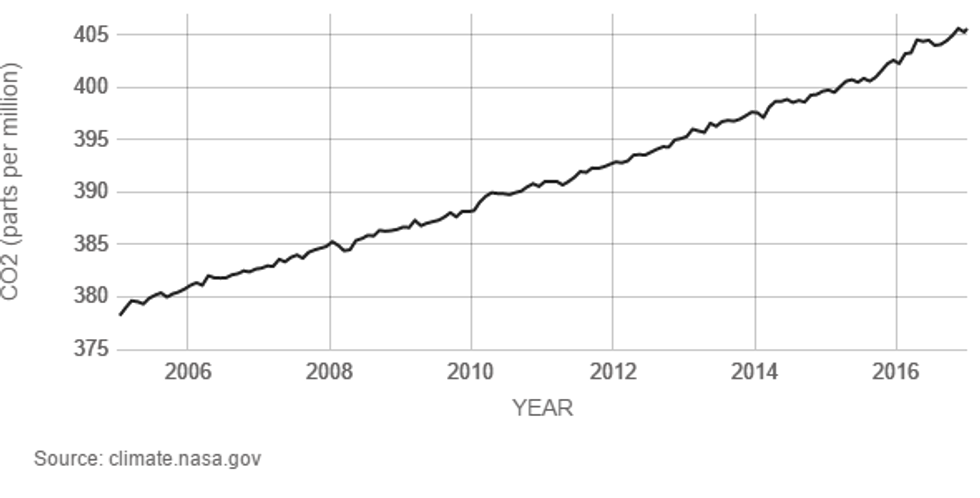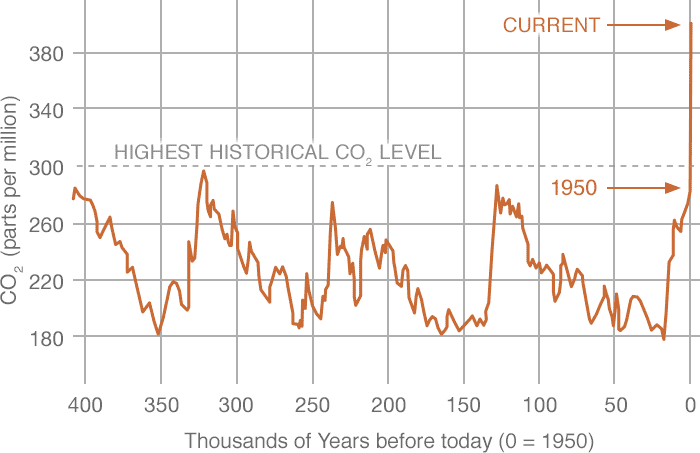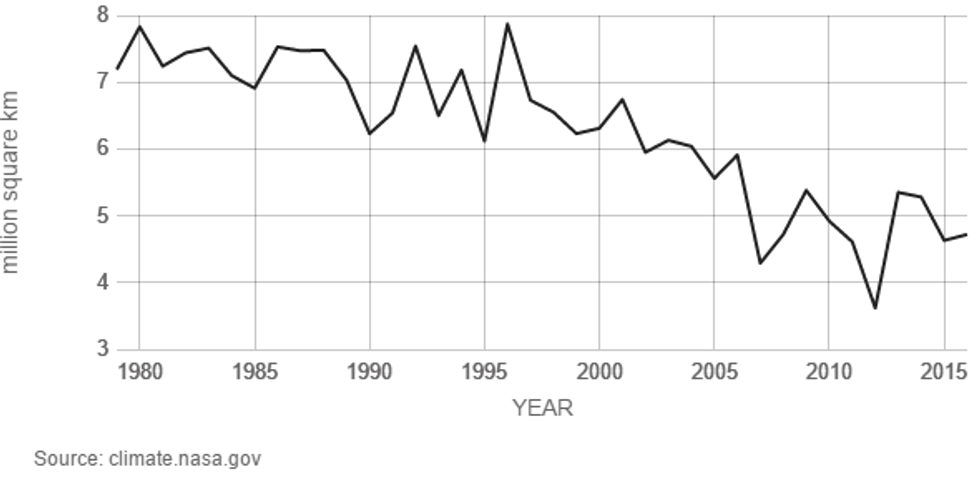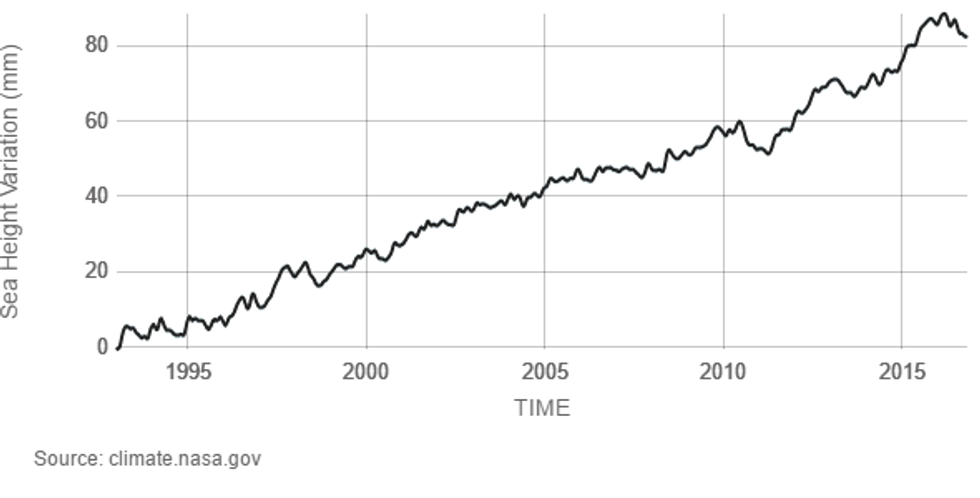Soon following Scott Pruitt's controversial appointment as EPA Administrator, the long-time critic of the EPA stated that he does not view carbon dioxide as a primary contributor toward global climate change. It is no secret that Scott Pruitt has a history of receiving large financial contributions from the fossil fuel industry, nor is it a secret that he vigorously opposes the agency which he now runs.
This single belief in particular, the belief that CO2 is not a primary cause of climate change, is enough to disqualify any person from running an agency based heavily on empirical data and decades of rigorous testing. However, let's start from the basic facts and work up to what could possibly be controversial about climate change. CO2 is a greenhouse gas. It has been a greenhouse gas throughout the entire existence of planet Earth. In fact, the high temperatures of Earth's prehistoric days are attributed to an enormous amount of CO2 in the atmosphere.
CO2 is a molecule which traps heat. It is emitted by various human activities including but not limited to fossil fuel burning, deforestation, and yes, even breathing. Clearly, some of our activities contribute more to climate change than others. On the graph below, provided by NASA and the National Atmospheric and Oceanic Administration (NOAA), we can see just how much Earth's CO2 levels have risen in the past 10 years.
For those who aren't used to parts per million (ppm), it is simply a unit of measuring concentrations. The healthy amount of CO2 is considered to be 350 ppm, or 350 CO2 molecules for every million molecules in the air. At the dawn of 2017, we are at 405 molecules of CO2 for every million molecules in the atmosphere. This number has risen dramatically since the 1950s, where fossil fuel burning began to dominate our planet on an unprecedented scale.
By studying that second graph, you may notice that CO2 levels have peaked and dropped every so often even without all of that industrialization. A good observation, but also worth noting how CO2 levels have by far exceeded our historical record starting after the 1950s. The scientific consensus does not state that man-made CO2 emissions are the only cause of climate change, but that man-made CO2 emissions have accelerated warming at an alarming rate.
These are the basics of climate science. This is not political, it is not debatable, it is what we have observed through decades upon decades of peer-reviewed, empirical, and rigorous scientific assessment. The temperature anomaly has been discovered and widely agreed upon by international climate agencies. Now we can move on to the more "debatable" things.
Is our CO2 level really a problem today? Why do we need to transform our energy system? Can't we wait just a few more decades of burning oil and ignoring alternative energy?
There is a misconception that climate change is a problem for the end of this century, but the damage has been occurring. Global temperature is the highest it has been since the year 1880, with 15 out of the last 16 years being the warmest on record since 1880. After 1970, global temperature has done nothing but climb steadily. The smallest temperature changes in a short amount of geologic time can have irreversible and tragic consequences on the planet.
For example, we are losing Arctic sea ice at a rate of 13.3% per decade. This is our planet's cooling system, as ice is supposed to reflect sunlight, heat, and radiation back into space. When seas and temperatures warm, there is less ice cover to perform this vital function. This is perhaps one of the most dangerous mechanisms of climate change.
This graph shows how we are on a slight incline, but the average is what tells us the full story. Our baseline for this graph is a bit before the year 1980. Since 1980 through 1995, we have never had the same level of sea ice as the previous years. Speaking of the sea, and keeping in mind that critical year of 1995, let's see how much sea level has risen in the past 21 years.
This graph shows seas rising at an average of 3.4 millimeters per year. Notice how from 1995, the trend is in the opposite direction of Arctic ice loss. As the ice was at its higher point in 1995, sea level rise was fairly low. The drop near the year 2000 shows that as the ice was lost, sea level began to climb. After another sea ice drop in 2010, sea level began to rise significantly yet again. This is a now problem rather than a later problem.
Why do we need to transform our energy system and work right now to combat climate change? Because by the time fossil fuels run out, it will be too late. We do need fossil fuels at the moment to keep us going during the transition. We need fossil fuels right now to manufacture and start up solar and wind farms as well as hydropower dams. By the time the crisis becomes too big to deny, we will not have the available resources to switch. We also cannot turn back time.
Upon recalling elementary school social studies, we know that oil, coal, and gas are nonrenewable. They cannot be readily replenished by the planet. These resources will run out. So will the materials to build alternative energy structures. Earth has limits that are beyond our control whether we accept it or not. No amount of human arrogance or dominion will change this. Only human ingenuity, intelligence, and international cooperation can do this.
We can and should debate when fossil fuels will run out but must do so without influence from non-scientific sources. Whenever that year may be, whenever we start experience global energy shortages and struggle to power whatever is left, fossil fuels will run out. There is no doubt or debate about that happening.
Perhaps it is time to move from oil business to energy business.

























